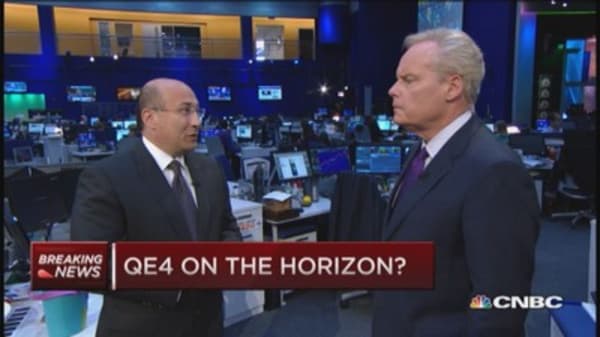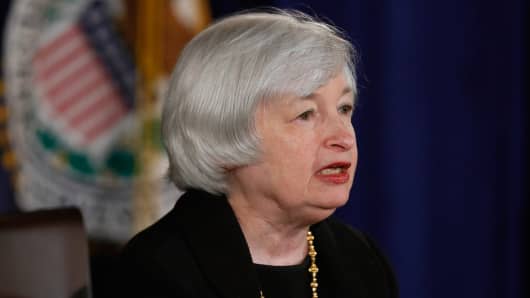Earlier this week, San Francisco Federal Reserve President, John Williams said that, under the proper circumstances, he would be open to another round of bond buying or, quantitative easing, as it's known at the Federal Reserve, to safeguard the economic recovery here at home.
From my vantage point, the Fed no longer needs to worry about tamping down long-term interest rates. Wednesday's plunge in global financial markets, record low interest rates in Germany and Japan, and the plunge in the 10-year note yield to an intraday low of 1.86 percent, should be all the evidence the Fed needs to shift its gaze from holding down rates to speeding up the velocity of the money supply.
The threat of global deflation continues to grow. China's wholesale prices are down 1.8 percent, year-over-year. Europe's inflation rate is at a five-year low. Inflation expectations in the U.S., have fallen back to 15-month lows, as measured by the so-called TIPS Spread, the difference between implied yields on inflation-protected bonds and regular Treasurys. Producer prices, as reported by the Labor Department, fell 0.1 percent last month, while most measure of domestic inflation have been below the Fed's 2-percent target for 29 months in a row.
All of those factors have been evident in the extraordinary plunge in global interest rates, reducing the need for the Fed to hold them down. Bond yields are plunging on worries of a global recession and the return of deflation.
Read MoreObamacare could delay a Fed rate hike
Since rates are likely to stay down, I would argue the Fed should look to other unconventional measures to prevent deflation from setting in here, even if it remains a clear and present danger overseas.
The Fed could, for example, stop paying banks interest on excess reserves held at the Fed. Currently, U.S. banks have parked a whopping $2.7 trillion at the Fed and are being paid a quarter point on those deposits. The Fed could cut that deposit rate to zero, or in a more draconian measure, actually charge banks for the privilege of leaving their money in the Fed's vaults.
That is something you will find in the Fed's literature describing ways to get more money circulating in the economy at a faster pace than is currently the case.
The speed at which the money supply turns over is called the velocity of money. The faster the turnover, at least theoretically, the faster the economy grows and the greater the chance that inflation would accelerate at a pace consistent with the Fed's mandate of price stability. (That means preventing not only inflation, but also deflation, by the way.) However, just forcing money back into the banking system does not ensure that it will be lent out, even to the most credit worthy borrowers.
Former Fed Chairman Ben Bernanke was apparently turned down when he tried to re-finance his mortgage. His work history was quite well-known. He reportedly makes $250,000 per speech and is writing a book. If the former head of the nation's central bank can't get approved for a re-fi, it seems pretty apparent that lending standards are too tight.
Read MoreOp-ed: Ben Bernanke, I feel your pain!
The Fed should take the lead, along with the Comptroller of the Currency, the Treasury, the FDIC and other regulators, to bring the banking business back to life.
in that way, the mechanism for transmitting the benefit of low rates can work to further revive the economy and insulate the U.S. from problems developing abroad.
In addition, although this is highly unlikely, Congress and the White House need to take steps to insulate both consumers and businesses from deflation and recession risk. Corporate, and individual, tax reform is a must. However, there is too much gridlock to pass that much-needed legislation. Another way to stimulate, and insulate, the consumer in particular, is to re-write pieces of the tax code.
Bringing back income averaging and tax deductions for credit-card interest payments would give the average citizen more disposable income, by decreasing his/her tax burden in ways that were common until the tax reform effort of 1986 did away with those personal perks.
Read MoreTighter monetary policy is already here: Insana
In short, despite the willingness of some Fed members to entertain another round of QE, I think the level of interest rates need not be targeted any longer. If the global economy continues to weaken, rates will fall under their own weight.
Escaping a liquidity trap, and speeding up the velocity of money, by other, less-discussed unconventional means would be a better policy prescription for what may soon ail — not just the global economy, but — our economy.
Commentary by Ron Insana, a CNBC and MSNBC contributor and the author of four books on Wall Street. He also editor of "Insana's Market Intellgence," available at Marketfy.com. He delivers a daily podcast, "Insana Insights," and a long-form weekly version, both available on iTunes and at roninsana.com. Follow him on Twitter @rinsana.





